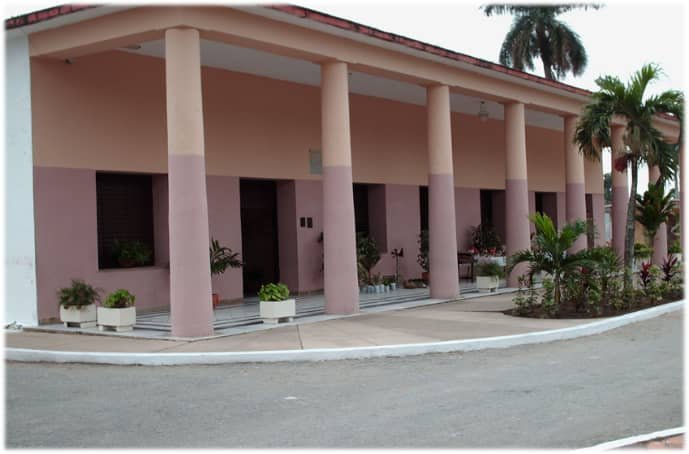
En el año 2009, me dieron el encargo de coordinar un proyecto investigativo sobre la historia de la Educación Técnica y Profesional en Pinar del Río. Comencé con miedo, fundado en aquel criterio de Don Miguel de Cervantes y Saavedra de que “Para componer historias y libros, de cualquier suerte que sean, es menester un gran juicio y maduro entendimiento”. Pero, muy a mi interior, me defendía la razón del periodista y escritor mexicano, Paco Ignacio Taibo II, quien aseguraba que “Un libro de historia, […], es una versión no definitiva de lo sucedido” y esta antítesis del algún modo me consolaba.
No partía de cero; tenía cierta información, por mi vocación hacia el conocimiento de la historia y por mi experiencia de casi 30 años como directivo de escuelas de formación profesional y Subdirector Provincial de la Educación Técnica y Profesional en la provincia. Con estas herramientas me sumergí en las preciosas, subyugantes y contradictorias páginas de la historia. Pronto me di cuenta que sabía muy poco sobre el tema.
La primera parte del proyecto fue publicada por la Editorial Hermanos Loynaz en el año 2019 y presentada en la feria del libro de 2020 como la “Historia de la Educación Técnica y Profesional en Pinar del Río”, el día 23 de marzo, un día antes de que el país tomara las primeras medidas por la COVID 19. La segunda parte se está escribiendo en estos momentos, por lo que la información que brindo ahora sobre una institución pinareña, solo corresponde hasta el año 1958.
In 2009 I was given the task of coordinating a research project on the history of Technical and Professional Education in Pinar del Río. I began with fear, based on that criterion of Don Miguel de Cervantes y Saavedra that "To compose stories and books, of whatever kind they may be, it is necessary a great judgment and mature understanding". But, deep inside me, I was defended by the reason of the Mexican journalist and writer, Paco Ignacio Taibo II, who said that "A history book, [...], is a non definitive version of what happened" and this antithesis somehow comforted me.
I did not start from scratch; I had some information, because of my vocation towards the knowledge of history and my experience of almost 30 years as a director of vocational schools and Deputy Provincial Director of Technical and Vocational Education in the province. With these tools I immersed myself in the precious, subjugating and contradictory pages of history. I soon realized that I knew very little about the subject.
The first part of the project was published by Editorial Hermanos Loynaz in 2019 and presented at the 2020 book fair as the "History of Technical and Professional Education in Pinar del Río", on March 23, a day before the country took the first steps by COVID 19. The second part is currently being written, so the information I provide now about a Pinar del Río institution only corresponds to 1958.
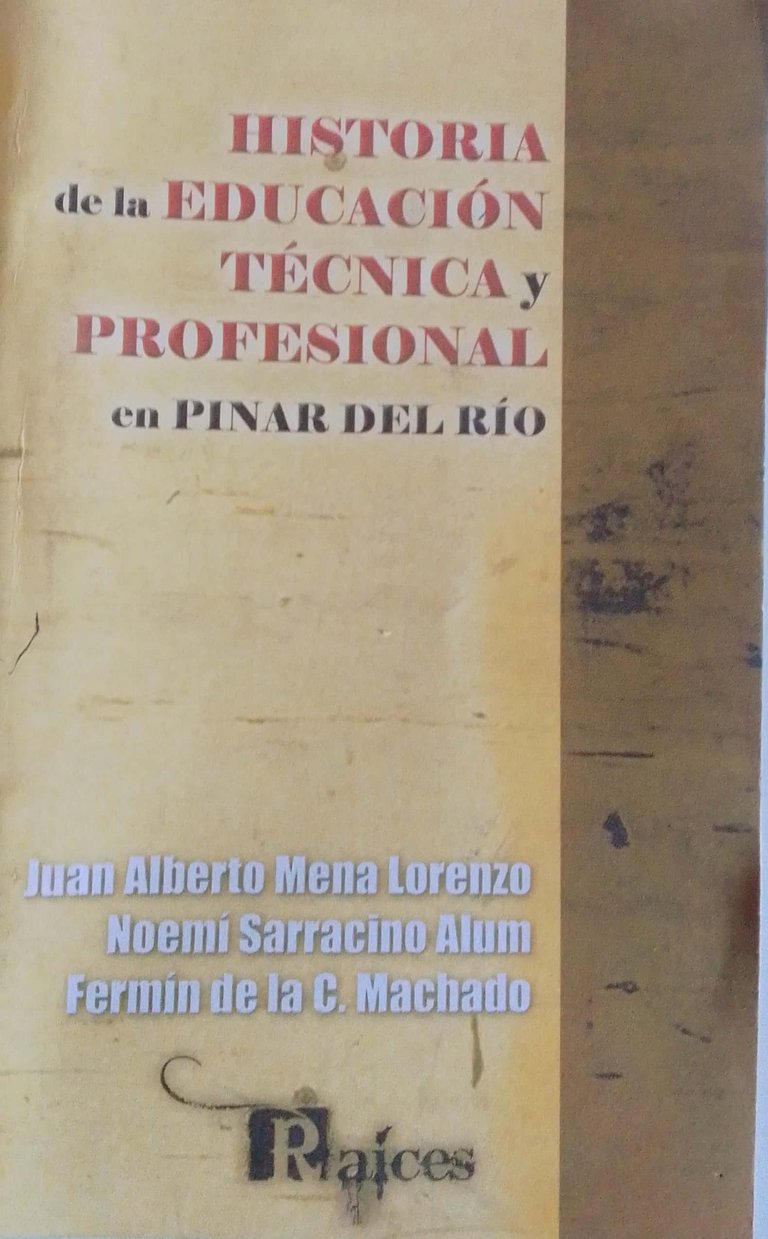
¿Sabían ustedes que Pinar del Río, cuenta con la escuela Agropecuaria más antigua de Cuba? Ahí les va mi relato.
El 18 de junio de 1909, la Secretaría de Agricultura, Comercio y Trabajo de la República de Cuba, emitió una ley para la creación de seis Granjas Escuelas Agrícolas en el país, una por cada provincia según la entonces división político-administrativa. Un año después, el 14 de junio de 1910, se dicta el reglamento para la ejecución de dicha ley.
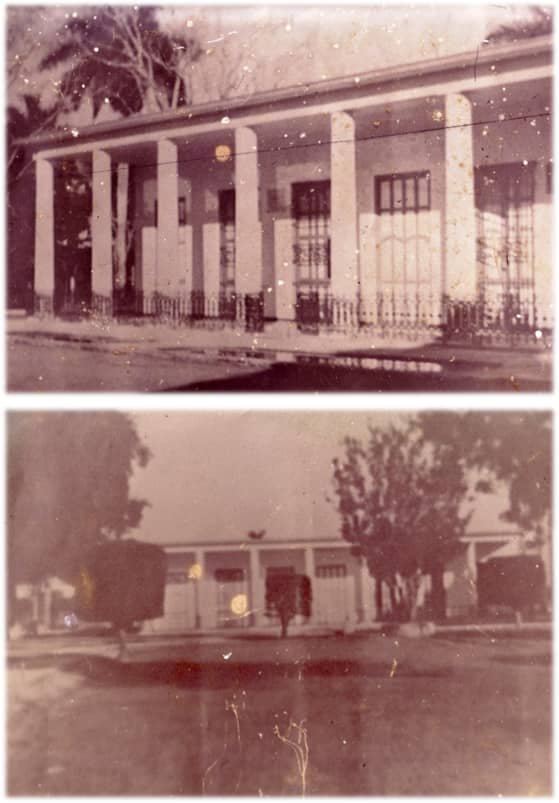
Para la construcción de la Granja Escuela de Pinar del Río, en 1911, se compró la finca “La Casualidad”, ubicada a ocho kilómetros de la ciudad cabecera en dirección al puerto pesquero La Coloma. Esta institución recibió desde su inicio el nombre del sabio vueltabajero “Tranquilino Sandalio de Noda”. Vale la pena señalar que esta finca, que poseía 4,1 caballerías de tierras, había pertenecido al rico terrateniente y esclavista español José Pérez y su hijo el naturalista canario Tiburcio Pérez Castañeda, marqués de Las Taironas. En ella Tranquilino, además de construir un herbario a solicitud de Pérez Castañeda, se practicaron los mejores métodos de cultivo y rotación de cosechas de la época y, además, se ensayaban las mejores y más modernas máquinas y fue aquí donde por primera vez en Vuelta Abajo, se aplicó el abono orgánico a las tierras dedicadas al cultivo del tabaco.
El hecho constituye un rico y valioso antecedente para una Granja escuela, que no pasó inadvertido para el lugarteniente general Antonio Maceo Grajales cuando acampó y durmió en este lugar, el 17 de enero de 1896, después de la importante batalla de "Las Taironas", una de las más trascendentes de la Campaña de Occidente durante la invasión desde el oriente del país. Como se sabe, una de las políticas de la invasión era la de aplicar la Tea Incendiaria donde quiera que se encontraran objetivos económicos que respondieran a la corona española. Sin embargo, según contaban los trabajadores de la finca y los habitantes de la zona, Maceo no quemó la finca intuyendo que podía ser útil para la provincia y el país una vez ganada la guerra.
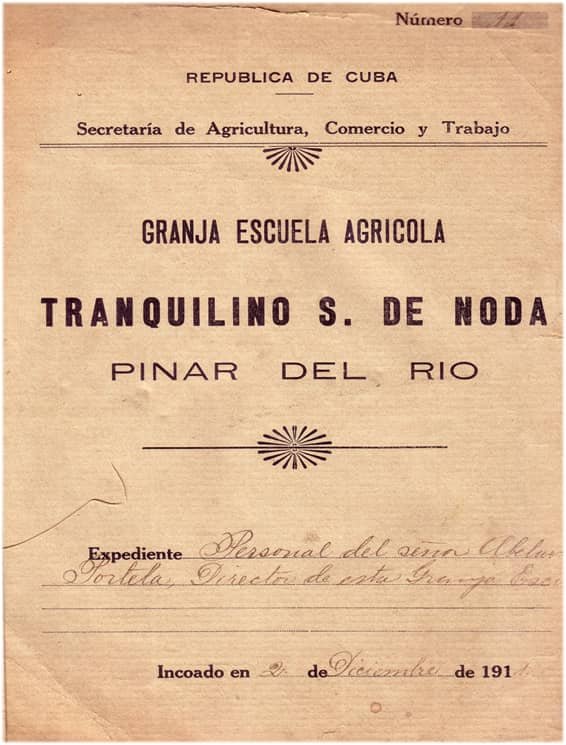
Con la designación, el dos de diciembre de 1911, del Sr. Abelardo Portela como primer director, comenzaron los trabajos de adaptación de la vivienda y locales existentes en la finca. Además, se adquirieron tierras para cultivo y cría de animales, ejemplares de diferentes especies, aparatos y edificaciones necesarias. Todo con una asignación de 45. 000 pesos.
En noviembre de 1912, el Dr. Victorio R. Ventura, sustituye a Portela como director de la institución, que fue inaugurada el 26 de enero de 1913, por lo que en el momento que se escribe este post cumple 110 años, 8 meses y 3 días.
Para la conformación del claustro se siguió un riguroso examen de oposición ante un tribunal de cinco miembros integrado por dos profesores de la Universidad de la Habana, un representante de la Academia de Ciencias, uno de la Secretaría de Agricultura y uno de la Secretaría de Instrucción Pública.
Did you know that Pinar del Río has the oldest agricultural school in Cuba? Here is my story.
On June 18, 1909, the Secretariat of Agriculture, Commerce and Labor of the Republic of Cuba issued a law for the creation of six Agricultural Farm Schools in the country, one for each province according to the then political-administrative division. One year later, on June 14, 1910, the regulations for the execution of said law were issued.
For the construction of the Pinar del Río Farm School, in 1911, the farm "La Casualidad" was purchased, located eight kilometers from the capital city in the direction of the fishing port of La Coloma. From the beginning, this institution was named after the wise man from Pinar del Rio "Tranquilino Sandalio de Noda". It is worth noting that this farm, which owned 4.1 caballerias of land, had belonged to the wealthy Spanish landowner and slave owner José Pérez and his son, the Canary Islands naturalist Tiburcio Pérez Castañeda, Marquis of Las Taironas. Here Tranquilino, in addition to building a herbarium at the request of Pérez Castañeda, practiced the best methods of cultivation and crop rotation of the time and also tested the best and most modern machines and it was here where for the first time in Vuelta Abajo, organic fertilizer was applied to the land dedicated to tobacco cultivation.
The fact constitutes a rich and valuable antecedent for a Farm School, which did not go unnoticed by Lieutenant General Antonio Maceo Grajales when he camped and slept in this place, on January 17, 1896, after the important battle of "Las Taironas", one of the most transcendent of the Western Campaign during the invasion from the east of the country. As it is known, one of the policies of the invasion was to apply the Tea Incendiaria wherever economic targets that responded to the Spanish crown were found. However, according to the workers of the farm and the inhabitants of the area, Maceo burned the farm intuiting that it could be useful for the province and the country once the war was won.
With the appointment, on December 2, 1911, of Mr. Abelardo Portela as the first director, work began on adapting the existing housing and premises on the farm. In addition, land was acquired for cultivation and animal husbandry, specimens of different species, equipment and necessary buildings. All with an allocation of 45,000 pesos.
In November 1912, Dr. Victorio R. Ventura replaced Portela as director of the institution, which was inaugurated on January 26, 1913, making it 110 years, 8 months and 3 days old at the time of writing this post. A rigorous competitive examination was held before a five-member tribunal composed of two professors from the University of Havana, a representative of the Academy of Sciences, one from the Secretariat of Agriculture and one from the Secretariat of Public Instruction.
Todo ciudadano cubano tenía derecho a solicitar una plaza. Los aspirantes debían pasar, de manera simultánea, tres pruebas: un documento sobre las cátedras o asignaturas solicitadas con la propuesta de contenidos y recursos necesarios, así como la concepción didáctica para su desarrollo, todo discutido con los miembros del tribunal; el segundo ejercicio lo hacían los aprobados en el primero, debían disertar durante 45 minutos, sobre 12 temas de agronomía escogidos al azar. En el tercer ejercicio, el tribunal citaba a los aspirantes aprobados y les indicaba el desarrollo de un tema de forma práctica.
Cada cuatro años los profesores seleccionados debían elaborar un material bibliográfico actualizado sobre las materias a su cargo. El material era evaluado y aprobado por el Director de Agricultura, el Director de la Estación Experimental de Agronomía de Santiago de las Vegas y el Inspector General de Agricultura.
El ejercicio se mantuvo de manera similar durante los próximos 45 años. Como resultado, el claustro era de altísima calidad. Prueba fehaciente de ello fue que el Dr. Carlos M. de la Rionda Perdomo, catedrático titular y director de la Granja Escuela durante tres periodos, en 1934 fue es designado Secretario de Agricultura y Comercio (Ministro) del Gabinete presidencial de Carlos Mendieta.
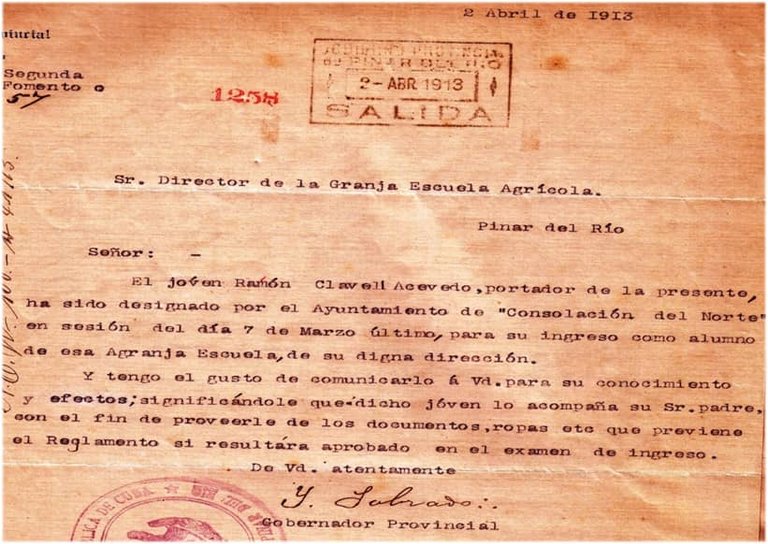
La matrícula de la escuela era de 20 alumnos (después aumentó a 60) de toda la provincia. Para ser seleccionados debían tener: más de 14 años, ser cubano por nacimiento, tener buena constitución física, vencer un examen de escritura al dictado, Geografía de Cuba y breves nociones de Aritmética.
No obstante, al requisito de nacionalidad, desde el propio año de 1913 y hasta 1938, estudiaron en la escuela estudiantes peruanos, salvadoreños, colombianos, hondureños, guatemaltecos y etíopes
La mitad de los alumnos matriculados debían ser hijos de campesinos, propuestos en los ayuntamientos municipales y aprobados en el provincial. (foto) una parte de las matrículas se integraron por estudiantes hijos de campesinos; además, matriculaban otros jóvenes del pueblo que utilizaron la escuela como vía para continuar estudios posteriores.
Every Cuban citizen had the right to apply for a position. The applicants had to pass, simultaneously, three tests: a document on the professorships or subjects requested with the proposal of contents and necessary resources, as well as the didactic conception for its development, all discussed with the members of the tribunal; the second exercise was made by those approved in the first one, they had to dissert for 45 minutes, on 12 topics of agronomy chosen at random. In the third exercise, the examining board summoned the successful candidates and instructed them to develop a topic in a practical way.
Every four years, the selected teachers had to prepare updated bibliographic material on the subjects they were in charge of. The material was evaluated and approved by the Director of Agriculture, the Director of the Experimental Station of Agronomy of Santiago de las Vegas and the Inspector General of Agriculture.
The exercise continued in a similar fashion for the next 45 years. As a result, the faculty was of the highest quality. Proof of this was that Dr. Carlos M. de la Rionda Perdomo, full professor and director of the Granja Escuela for three terms, was appointed Secretary of Agriculture and Commerce (Minister) in the presidential Cabinet of Carlos Mendieta in 1934.
The school's enrollment was 20 students (later increased to 60) from all over the province. To be selected they had to be over 14 years old, be Cuban by birth, have a good physical constitution, pass a dictated writing exam, Cuban Geography and brief notions of Arithmetic.
Notwithstanding the nationality requirement, from 1913 until 1938, Peruvian, Salvadoran, Colombian, Honduran, Guatemalan and Ethiopian students studied at the school.
Half of the students enrolled had to be the children of peasants, proposed by the municipal councils and approved by the provincial council. (photo) part of the enrollment was made up of students who were the children of peasants; in addition, other young people from the town who used the school as a way to continue their studies were enrolled.
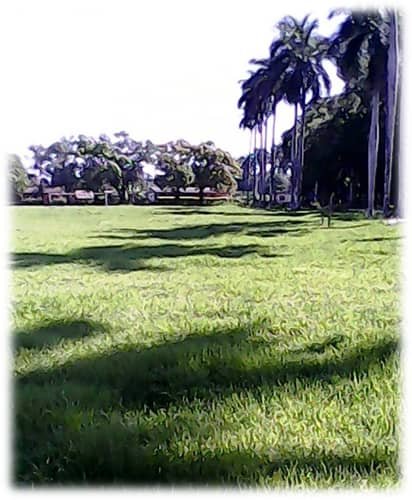
Según el Maestro Agrícola Pablo Medina Clausel (ya fallecido), profesor de la escuela por más de 40 años, como prueba vocacional los estudiantes debían limpiar con machete un potrero o área infestada de malezas (área que ocupa el terreno de futbol en la actualidad (foto). Si el estudiante se quejaba por las lógicas ampollas que surgían, el profesor le indicaba que se orinara en las manos, de modo que se fueran curtiendo y formando callos. Sólo aquellos que terminaban completamente el trabajo eran admitidos ¡Dura prueba!
Hasta 1958, los estudiantes egresaban como Maestros de Cultivo, Maestros Agrícolas y Agricultores Prácticos. En 1934, la escuela modifica su plan se estudios y pasa a llamarse Escuela Provincial de la Agricultura, aunque todo el mundo le siguió llamando “La Granja”.
Se necesitan varios post para contar la historia de estos primeros 45 años, por lo que a partir de aquí solo haremos referencia a algunos hechos que den una idea de la alta calidad del trabajo de pedagógico-investigativo de la institución en la formación de los profesionales de la agricultura.
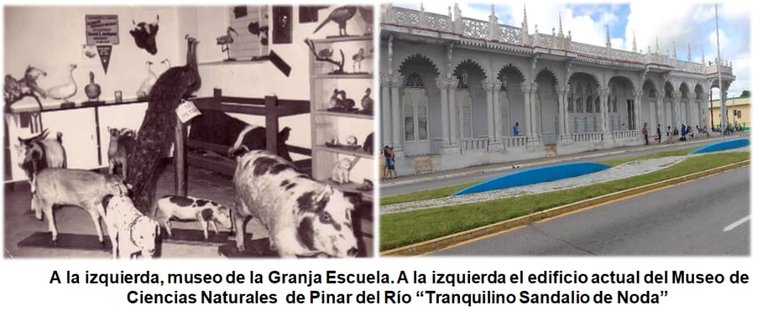
Uno de ellos es que, en 1934, el Maestro Agrícola Filomeno Corrales Miranda graduado en 1922 en la granja gana una plaza como Mayordomo (labor docente de carácter práctico) y profesor de Botánica y Biología. Filomeno, especializado como taxidermista, creó el Museo de Historia Natural de la Granja Escuela que hoy constituye en el Museo Provincial de Ciencias Naturales “Tranquilino Sandalio de Noda”, ubicado en el palacio Wuash. Se puede afirmar que el germen del museo provincial estuvo en la Granja Escuela.
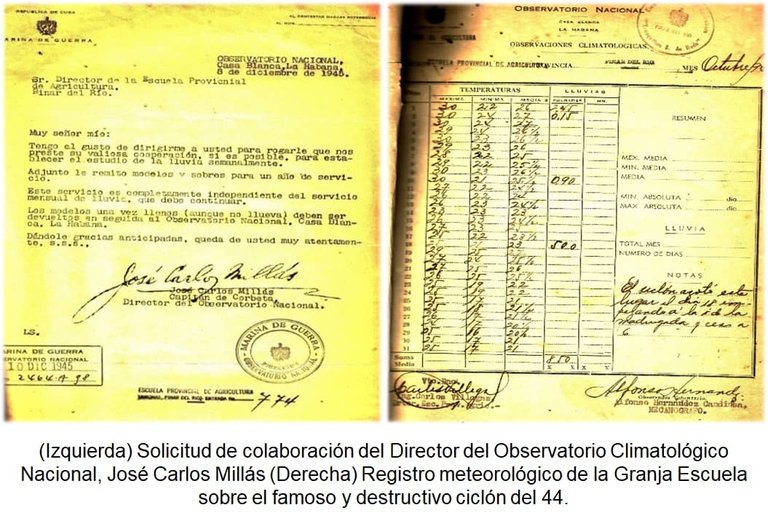
En 1940, el Profesor Titular Armando Díaz Bravo, connotado masón pinareño cuya logia lleva su nombre, crea en la granja el Museo Agrológico Provincial, que tenía muestras de suelos y sustratos de todo el territorio vueltabajero.
Otro de los ejemplos significativos fueron los registros de observaciones climatológicas (temperaturas, precipitaciones), observados, recogidos y anotados de manera diaria desde 1925 Tenían tal precisión que eran requeridos de manera sistemática por el por el Capitán de Corbeta José Carlos Millas, director del Observatorio Nacional de Casa Blanca.
According to Maestro Agrícola Pablo Medina Clausel (now deceased), a teacher at the school for more than 40 years, as a vocational test the students had to clean with a machete an area infested with weeds (the area currently occupied by the soccer field (photo). If the student complained about the blisters, the teacher instructed him to urinate on his hands, so that they would heal and form calluses. Only those who completely finished the work were admitted to the course, a tough test!
Until 1958, students graduated as Master Farmers, Master Farmers and Practical Farmers. In 1934, the school changed its curriculum and was renamed the Provincial School of Agriculture, although everyone continued to call it "La Granja".
It would take several posts to tell the story of these first 45 years, so from here on we will only refer to some facts that give an idea of the high quality of the pedagogical-research work of the institution in the training of agricultural professionals.
One of them is that, in 1934, the Agricultural Master Filomeno Corrales Miranda graduated in 1922 in the farm wins a position as Butler (practical teaching work) and professor of Botany and Biology. Filomeno, specialized as a taxidermist, created the Museum of Natural History of the Farm School that today constitutes the Provincial Museum of Natural Sciences "Tranquilino Sandalio de Noda", located in the Wuash Palace. It can be affirmed that the germ of the provincial museum was in the Granja Escuela.
In 1940, Professor Armando Díaz Bravo, a noted Pinar del Río Mason whose lodge bears his name, created the Provincial Agrological Museum at the farm, which had samples of soils and substrates from all over the territory of Pinar del Río.
Another significant example were the records of climatological observations (temperatures, precipitations), observed, collected and noted on a daily basis since 1925. They were so accurate that they were systematically required by Lieutenant Commander José Carlos Millas, director of the National Observatory of Casa Blanca.

Por último y sin desconocer otros hechos, merece destacar el trabajo realizado en el ámbito deportivo. Un ejemplo de ello fue el equipo de béisbol, donde militaba como primera base el estudiante Julio Bécquer, quien entre los años 1951 y 1963, se destacaría como excelente jugador en la Liga Profesional Cubana (Club Marianao), con record de jonrones para una temporada (1960-1961) y, en la Liga Profesional estadounidense (MLB) (Washington Senators, Minnesota Twins; California Angels, Philadelphia Phillies).
Solo les he contado una pequeña parte de esta etapa; la Granja Escuela ha continuado una labor meritoria hasta la actualidad. El 26 de enero de este año 2023 cumplió los 110 años; pero esa información pertenece a otros post.
Finally, and without ignoring other facts, it is worth mentioning the work done in the sports field. An example of this was the baseball team, where the student Julio Bécquer played first base, who between 1951 and 1963, would stand out as an excellent player in the Cuban Professional League (Club Marianao), with a home run record for one season (1960-1961) and in the American Professional League (MLB) (Washington Senators, Minnesota Twins; California Angels, Philadelphia Phillies).
I have only told you a small part of this stage; the Farm School has continued a meritorious work until today. On January 26 of this year 2023 it turned 110 years old; but that information belongs in other posts.
Todas las fotografías e imágenes de documentos pertenecen al proyecto investigativo “La Historia de la Educación Técnica y Profesional en Pinar del Río. Textos llevados al inglés por Deepl Traslate
All photographs and images of documents belong to the research project "The History of Technical and Professional Education in Pinar del Río. Texts translated into English by Deepl Translate.
Importantísima historia que nos has contado y seguro nos dará por para seguir indagando sobre esta prestigiosa institución.
Creo que no debemos olvidar nuestra historia. Es ella quien nos trajo hasta aquí. Gracias
Muy interesante historia sobre esta institución, gracias por compartirnosla, estoy convencida que muchos no la conocen. Un saludo y feliz domingo.
Creo que el conocimiento y la historia debemos compartirla; no nos pertenece y es se todos. Gracias
Pinar y su gente, gracias por compartir este rememorable recuerdo, la historia de Pinar del Río está muy influenciada por la gran cantidad de reformas agrarias luego del 59, hoy en día continúa siendo un productor agrícola aunque mucho más decaído.
Saludos, muchísimas gracias por guardar en tu blog estos retazos de la historia de Vueltabajo🙌🙌🙌🙌
La gente tiene el derecho y el deber de conocer la obra de quienes nos antecedieron. En la era de las Tic, hay personas que ven a nuestros antecesores como iletrados carentes de cultura. Hay que contar la historia para que no cundan la "fiebre del olvido". Gracias.
Una gran historia la de esa institución. Un lugar muy hermoso además.
Congratulations @bertico! You have completed the following achievement on the Hive blockchain And have been rewarded with New badge(s)
Your next payout target is 250 HP.
The unit is Hive Power equivalent because post and comment rewards can be split into HP and HBD
You can view your badges on your board and compare yourself to others in the Ranking
If you no longer want to receive notifications, reply to this comment with the word
STOPTo support your work, I also upvoted your post!
Check out our last posts: